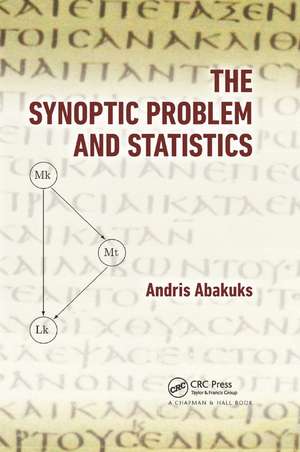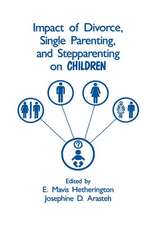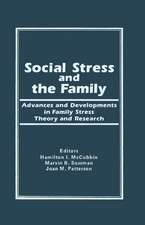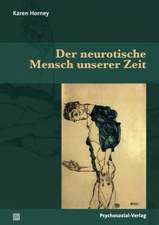The Synoptic Problem and Statistics
Autor Andris Abakuksen Limba Engleză Paperback – 18 sep 2018
The Synoptic Problem and Statistics lays the foundations for a new area of interdisciplinary research that uses statistical techniques to investigate the synoptic problem in New Testament studies, which concerns the relationships between the Gospels of Matthew, Mark, and Luke. There are potential applications of the techniques to study other sets of similar documents.
Explore Hidden Markov Models for Textual Data
The book provides an introductory account of the synoptic problem and relevant theories, literature, and research at a level suitable for academic and professional statisticians. For those with no special interest in biblical studies or textual analysis, the book presents core statistical material on the use of hidden Markov models to analyze binary time series. Biblical scholars interested in the synoptic problem or in the use of statistical methods for textual analysis can omit the more technical/mathematical aspects of the book. The binary time series data sets and R code used are available on the author’s website.
Preț: 351.97 lei
Preț vechi: 469.12 lei
-25% Nou
Puncte Express: 528
Preț estimativ în valută:
67.37€ • 73.20$ • 56.63£
67.37€ • 73.20$ • 56.63£
Carte tipărită la comandă
Livrare economică 21 aprilie-05 mai
Preluare comenzi: 021 569.72.76
Specificații
ISBN-13: 9781138374782
ISBN-10: 1138374784
Pagini: 215
Ilustrații: 33
Dimensiuni: 156 x 234 mm
Greutate: 0.4 kg
Ediția:1
Editura: CRC Press
Colecția Chapman and Hall/CRC
ISBN-10: 1138374784
Pagini: 215
Ilustrații: 33
Dimensiuni: 156 x 234 mm
Greutate: 0.4 kg
Ediția:1
Editura: CRC Press
Colecția Chapman and Hall/CRC
Cuprins
Introduction to the Gospel Texts and the Synoptic Problem. The Triple-Link Model. Matthew's and Luke's Use of Mark: A Logistic Regression Approach. Hidden Markov Models for Binary Time Series. Matthew's and Luke's Use of Mark: Hidden Markov Models. Mark’s and Luke’s Use of Matthew. Examples of Synoptic Parallels. Final Conclusions. Appendix. Bibliography. Index.
Notă biografică
Andris Abakuks is a lecturer in statistics at Birkbeck, University of London. His research focuses on the application of probability and statistics to problems in theology and New Testament studies.
Recenzii
"… a selection of interesting passages identified thanks to the application of statistical methods undergoes a careful textual and philological analysis. The book ends by hinting at directions for further study. The R code included in the annexes will certainly be helpful for readers interested in applying the methods described in the book."
—Significance, August 2015
"It is difficult to overstate the importance of Andris Abakuks’ work within the field of New Testament (NT) studies. The statistical analysis of NT texts tends to be difficult for NT scholars, who generally lack the training to utilize, or even to understand, the statistical analysis of NT texts and related problems. Conversely, statisticians generally lack much feel for NT problems or Koiné Greek. But Abakuks is a bona fide statistician and an extremely adept NT analyst. Here he brings complete statistical competence—and indeed brilliance—to bear on the Synoptic problem in a wonderfully insightful and lucid fashion. As a result, he not only moves this deeply contested and profoundly difficult debate forward, essentially endorsing the Farrer hypothesis that Luke used both Mark and Matthew. But he offers fresh insights to all NT scholars who are reengaging with the importance of statistics for NT interpretation. The NT field has rather fallen behind as computer-assisted textual analysis has surged ahead in the last 25 years. Abakuks is consequently a very important voice indeed, signaling the re-emergence of this significant interdisciplinary conversation. NT scholars have much to learn from him, in all sorts of ways."
—Douglas A. Campbell, Professor of New Testament, The Divinity School, Duke University
"Abakuks argues that a revised triple-link model explains the data for Synoptic agreements. Serious statistical methods are used here, as also to obtain and assess evidence that Matthew and Luke are more similar in their editing of Mark than would be expected if they were writing independently. This is a careful and rigorous study, and its conclusions are cautiously stated. It is essential reading for anyone concerned with the Synoptic problem."
—Dr. David Mealand, University of Edinburgh
"There are very few people qualified to write authoritatively in two fields apparently so diverse as statistics and biblical studies. Andris Abakuks is one such. In this book, the author tackles the much-debated synoptic problem concerning the order and manner of composition of the first three gospels in the New Testament. By applying sophisticated statistical methods, he is able to identify critical passages, which are central to the determination of a solution of the synoptic problem. Abakuks’ treatment is thorough, judicious, and balanced. His analysis strongly suggests that the widely held belief among biblical scholars that there was an additional source, known as Q and no longer extant, is not well supported by the statistical analysis. In effect, he shows that is not necessary to postulate the existence of Q to explain what is common to the three gospels—though it is not definitively ruled out. Statisticians will be particularly interested to see the new techniques based on hidden Markov models applied to textual data and to see what they can achieve."
—David J. Bartholomew, Professor Emeritus of Statistics, London School of Economics and Political Science
"In this groundbreaking monograph, academic statistician and New Testament scholar Andris Abakuks applies his redoubtable statistical expertise to the question of the literary relationships between the Synoptic Gospels. Abakuks investigates a variety of models that seek to explain these relationships, giving particular attention to the two-source model, which proposes that Matthew and Luke used as their main sources Mark’s Gospel and a hypothetical document labelled Q. He shows that while statistical analysis fits well enough with the assumption that Matthew and Luke were reliant on Mark, it casts serious doubt on the view that they drew from Mark independently of each other, which is intrinsic to the Q hypothesis. This book is one of the most significant contributions to the Synoptic Problem in many years. It is the most sophisticated and thorough statistical treatment of the problem ever produced, and it offers a formidable new statistical argument against Q."
—Dr. Edward Adams, Professor of New Testament Studies, King’s College London
—Significance, August 2015
"It is difficult to overstate the importance of Andris Abakuks’ work within the field of New Testament (NT) studies. The statistical analysis of NT texts tends to be difficult for NT scholars, who generally lack the training to utilize, or even to understand, the statistical analysis of NT texts and related problems. Conversely, statisticians generally lack much feel for NT problems or Koiné Greek. But Abakuks is a bona fide statistician and an extremely adept NT analyst. Here he brings complete statistical competence—and indeed brilliance—to bear on the Synoptic problem in a wonderfully insightful and lucid fashion. As a result, he not only moves this deeply contested and profoundly difficult debate forward, essentially endorsing the Farrer hypothesis that Luke used both Mark and Matthew. But he offers fresh insights to all NT scholars who are reengaging with the importance of statistics for NT interpretation. The NT field has rather fallen behind as computer-assisted textual analysis has surged ahead in the last 25 years. Abakuks is consequently a very important voice indeed, signaling the re-emergence of this significant interdisciplinary conversation. NT scholars have much to learn from him, in all sorts of ways."
—Douglas A. Campbell, Professor of New Testament, The Divinity School, Duke University
"Abakuks argues that a revised triple-link model explains the data for Synoptic agreements. Serious statistical methods are used here, as also to obtain and assess evidence that Matthew and Luke are more similar in their editing of Mark than would be expected if they were writing independently. This is a careful and rigorous study, and its conclusions are cautiously stated. It is essential reading for anyone concerned with the Synoptic problem."
—Dr. David Mealand, University of Edinburgh
"There are very few people qualified to write authoritatively in two fields apparently so diverse as statistics and biblical studies. Andris Abakuks is one such. In this book, the author tackles the much-debated synoptic problem concerning the order and manner of composition of the first three gospels in the New Testament. By applying sophisticated statistical methods, he is able to identify critical passages, which are central to the determination of a solution of the synoptic problem. Abakuks’ treatment is thorough, judicious, and balanced. His analysis strongly suggests that the widely held belief among biblical scholars that there was an additional source, known as Q and no longer extant, is not well supported by the statistical analysis. In effect, he shows that is not necessary to postulate the existence of Q to explain what is common to the three gospels—though it is not definitively ruled out. Statisticians will be particularly interested to see the new techniques based on hidden Markov models applied to textual data and to see what they can achieve."
—David J. Bartholomew, Professor Emeritus of Statistics, London School of Economics and Political Science
"In this groundbreaking monograph, academic statistician and New Testament scholar Andris Abakuks applies his redoubtable statistical expertise to the question of the literary relationships between the Synoptic Gospels. Abakuks investigates a variety of models that seek to explain these relationships, giving particular attention to the two-source model, which proposes that Matthew and Luke used as their main sources Mark’s Gospel and a hypothetical document labelled Q. He shows that while statistical analysis fits well enough with the assumption that Matthew and Luke were reliant on Mark, it casts serious doubt on the view that they drew from Mark independently of each other, which is intrinsic to the Q hypothesis. This book is one of the most significant contributions to the Synoptic Problem in many years. It is the most sophisticated and thorough statistical treatment of the problem ever produced, and it offers a formidable new statistical argument against Q."
—Dr. Edward Adams, Professor of New Testament Studies, King’s College London
Descriere
This book lays the foundations for a new area of interdisciplinary research that uses statistical techniques to investigate the synoptic problem in New Testament studies, which concerns the relationships between the Gospels of Matthew, Mark, and Luke. There are potential applications of the techniques to study other sets of similar documents. The book presents core statistical material on the use of hidden Markov models to analyze binary time series. The binary time series data sets and R code used are available on the author’s website.









